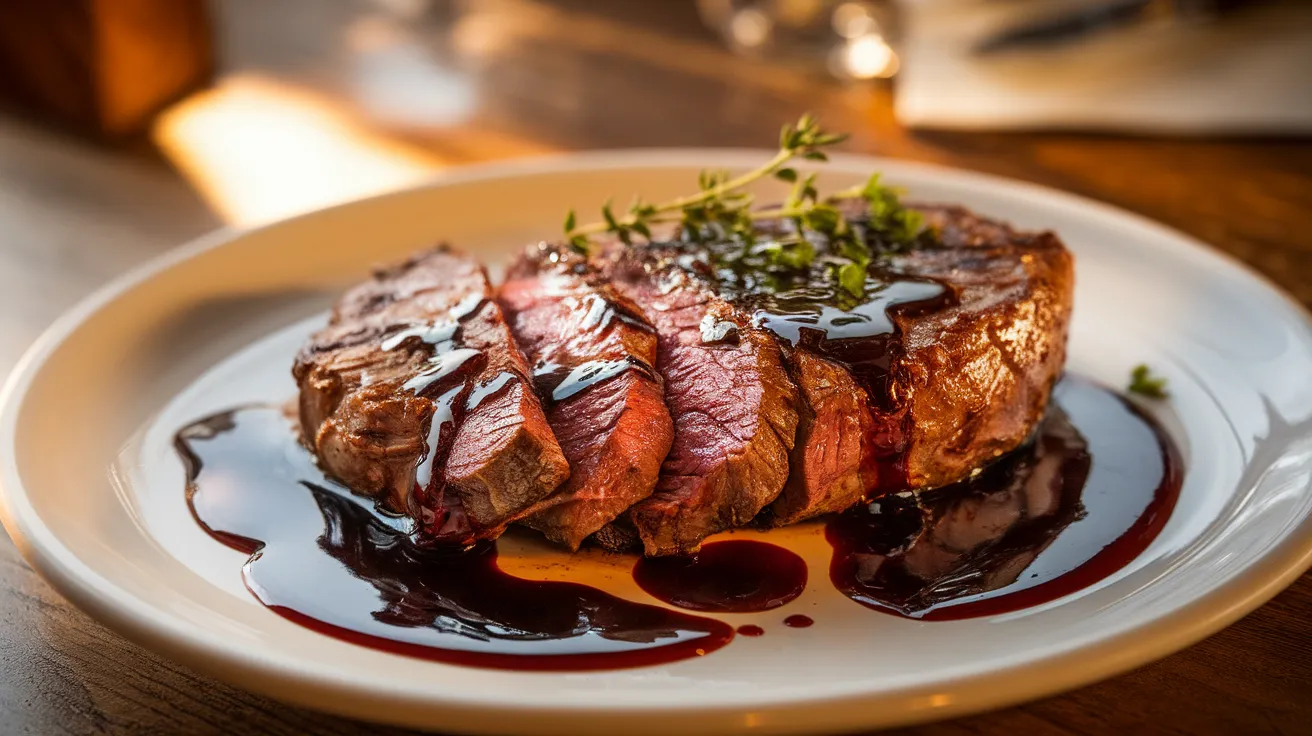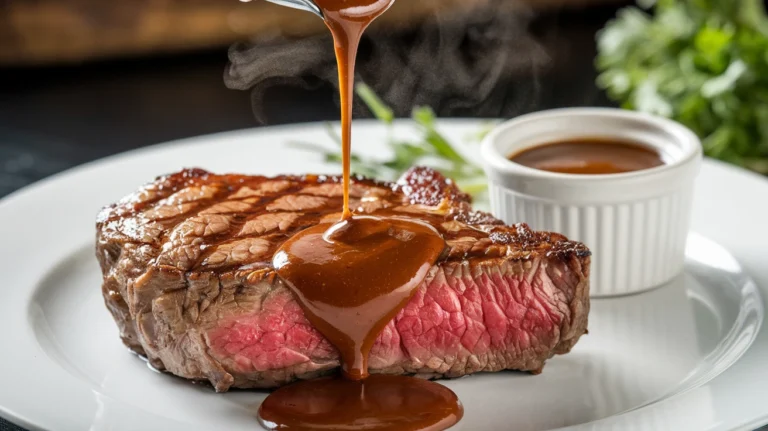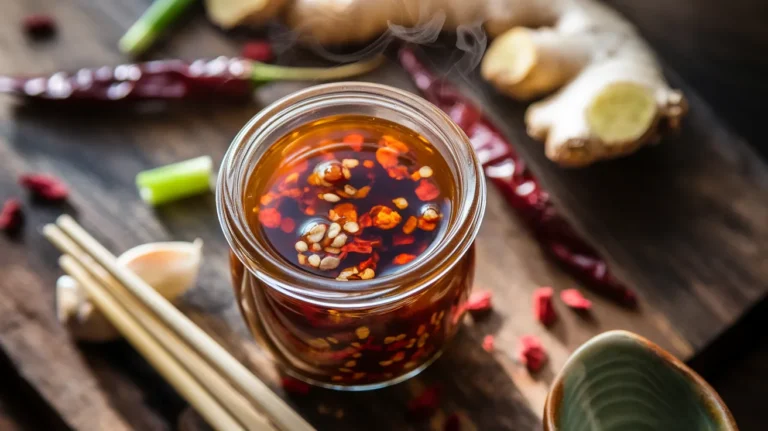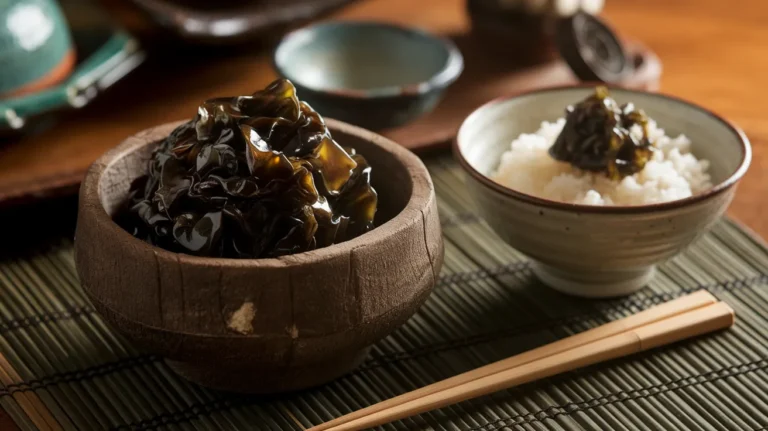This restaurant-quality sauce for venison steak elevates your wild game dinner into an unforgettable culinary experience. Our detailed sauce for venison steak recipe combines rich red wine with aromatic herbs and silky butter, creating the ideal complement to venison’s bold, earthy flavors. Perfect for beginners, this step-by-step guide ensures your sauce for venison steak turns out flawlessly every single time.
SERVES: 4 | PREP: 10 MIN | COOK: 15 MIN | TOTAL: 25 MIN
Ingredients for Your Venison Steak Sauce
For the Sauce Base
| Ingredient | Amount |
|---|---|
| Red wine (Cabernet Sauvignon or Merlot) | 1 cup |
| Beef or venison stock | 1 cup |
| Shallots, finely minced | 2 large |
| Fresh thyme sprigs | 3 |
| Bay leaf | 1 |
| Tomato paste | 1 tablespoon |
For the Finish
| Ingredient | Amount |
|---|---|
| Cold unsalted butter | 4 tablespoons |
| Heavy cream | 2 tablespoons |
| Fresh parsley, chopped | 2 tablespoons |
| Salt | To taste |
| Black pepper, freshly ground | To taste |
Detailed Step-by-Step Instructions for Sauce for Venison Steak
Phase 1: Preparing Your Base (8 minutes)
Step 1: Set Up Your Workspace Place all ingredients within arm’s reach of your stove. Have a wooden spoon, whisk, and measuring cups ready. This organization prevents rushing and ensures smooth cooking.
Step 2: Prepare Your Pan Heat a medium heavy-bottomed saucepan over medium heat for 1-2 minutes. Test the temperature by dropping a tiny piece of shallot into the pan—it should sizzle gently, not violently. If your pan isn’t non-stick, add 1 teaspoon of neutral oil to prevent sticking.
Step 3: Cook the Shallots Properly Add your finely minced shallots to the heated pan. You should hear a gentle sizzling sound—this is perfect. Stir constantly with a wooden spoon for 2-3 minutes. The shallots are ready when they become translucent and smell sweet and aromatic. Warning: If they start turning brown, lower your heat immediately—burnt shallots will make your sauce bitter.
Step 4: Build Depth with Tomato Paste Push the cooked shallots to one side of the pan and add the tablespoon of tomato paste to the empty space. Let it cook undisturbed for 30 seconds until it darkens slightly and becomes fragrant. Then stir it into the shallots. This technique, called “blooming,” intensifies the tomato flavor and adds rich color to your sauce for venison steak.
Phase 2: Wine Reduction Mastery (10 minutes)
Step 5: Deglaze with Wine Remove the pan from heat temporarily (safety first!). Pour in the red wine all at once—it will sizzle and steam dramatically. Return to heat and immediately scrape the bottom of the pan with your wooden spoon. Those browned bits (called fond) are pure flavor gold for your sauce.
Step 6: Add Your Aromatics Drop in the thyme sprigs and bay leaf. Don’t chop the thyme—whole sprigs are easier to remove later and won’t leave woody stems in your finished sauce.
Step 7: Master the Boil-and-Simmer Technique Increase heat to medium-high and bring the wine to a rapid boil—you’ll see large bubbles breaking the surface. Once boiling, immediately reduce heat to medium-low to maintain a steady simmer. You want small, consistent bubbles around the edges, not a violent boil that will make your wine taste harsh.
Step 8: Achieve Perfect Wine Reduction Simmer uncovered for 6-8 minutes, stirring occasionally. The wine is properly reduced when it coats the back of your spoon and you can draw a line through it with your finger that fills in slowly. You should have about 1/2 cup of liquid remaining. Visual Cue: The color will deepen to a rich burgundy, and the alcohol smell will be replaced by a sweet, concentrated wine aroma.
Step 9: Add Stock and Continue Reducing Pour in the beef or venison stock. The mixture will bubble up initially—this is normal. Continue simmering for another 4-5 minutes until the total liquid reduces to approximately 3/4 cup. Timing Tip: While this simmers, start resting your cooked venison steaks—they’ll be perfectly rested when your sauce is ready.
Phase 3: Creating Silky Perfection (4 minutes)
Step 10: Remove Aromatics Using tongs or a fork, carefully remove the thyme sprigs and bay leaf. Squeeze the thyme sprigs gently against the side of the pan to extract maximum flavor before discarding. Safety Note: Bay leaves can be sharp, so remove completely to avoid choking hazards.
Step 11: Master the Butter Mounting Technique This is the most critical step for achieving restaurant-quality sauce. Reduce heat to the lowest possible setting. Cut your cold butter into 4 equal pieces. Add one piece at a time, whisking constantly until each piece is completely incorporated before adding the next. Why This Works: Cold butter creates an emulsion that gives your sauce its glossy, velvety texture. Warning: If the sauce is too hot, the butter will separate and look greasy instead of smooth.
Step 12: Add Cream for Extra Richness Whisk in the heavy cream until completely combined. The sauce should now have a beautiful, glossy appearance that coats the whisk smoothly.
Step 13: Fresh Herb Finish Remove from heat completely and stir in the fresh chopped parsley. The residual heat will release the parsley’s bright flavor without cooking it.
Step 14: Season to Perfection Taste your sauce and season with salt and freshly ground black pepper. Start with 1/4 teaspoon salt and a few grinds of pepper, then adjust. Remember, venison is already flavorful, so your sauce should complement, not overpower.
Step 15: Optional Professional Straining For ultra-smooth, restaurant-quality texture, strain the sauce through a fine-mesh sieve into a clean small saucepan. Press the solids gently with the back of a spoon to extract maximum flavor.
Step 16: Final Temperature Check Your finished sauce should be warm, not hot. If it’s too cool, warm gently over the lowest heat for 30-60 seconds, whisking constantly. Serving Temperature: The sauce should feel comfortably warm when you dip a clean spoon into it.
Professional Chef’s Notes for Venison Steak Sauce
Wine Selection Mastery: Choose a red wine with good body and flavor that you’d enjoy drinking. Avoid cooking wines—they contain salt and preservatives that can make your sauce for venison steak taste artificial. Cabernet Sauvignon and Merlot work beautifully because their tannins complement venison’s rich flavor.
Temperature Control Success: Never let your sauce boil after adding butter—maintain the lowest heat setting. If you see any bubbling after the butter goes in, remove from heat immediately and whisk vigorously to save the emulsion.
Make-Ahead Strategy: Complete steps 1-9 up to 4 hours ahead. When ready to serve, reheat gently and add butter, cream, and parsley fresh. This technique actually improves flavor as the wine and stock have time to marry.
Consistency Troubleshooting: Your finished sauce should coat the back of a spoon but still pour smoothly. Too thick? Whisk in warm stock 1 tablespoon at a time. Too thin? Simmer briefly to reduce, then re-mount with butter.
Nutrition Information (Per Serving)
- Calories: 95
- Protein: 2g
- Carbohydrates: 4g
- Fat: 6g
- Sodium: 280mg
- Fiber: 0g
Creative Variations for Your Venison Steak Sauce
Wild Mushroom Enhancement: Sauté 1 cup sliced cremini or shiitake mushrooms with the shallots for an earthier sauce that perfectly complements game meat’s natural flavors. The mushrooms add texture and umami depth.
Herb Garden Blend: Replace thyme with fresh rosemary and sage (1 sprig each) for a more rustic, woodsy flavor profile that echoes venison’s wild origins. This variation is particularly stunning in fall.
European Sweet Touch: Stir in 2 tablespoons red currant jelly during the wine reduction for a traditional European-style sauce with subtle sweetness that balances venison’s intensity.
Juniper Berry Elegance: Add 1/2 teaspoon lightly crushed juniper berries with the aromatics for an authentically wild game sauce with complex, gin-like notes. This sophisticated variation pairs beautifully with other elegant dishes like our sauce for veal cutlets.
Storage & Reheating Your Sauce for Venison Steak
Refrigerator Storage: Transfer cooled sauce to an airtight container and refrigerate for up to 3 days. The flavors actually improve as they meld together overnight, making day-old sauce even more delicious.
Freezing Instructions: This sauce freezes beautifully for up to 2 months. Pour into ice cube trays for individual portions, then transfer frozen cubes to freezer-safe bags. Each cube equals about 2 tablespoons—perfect for single servings.
Gentle Reheating Method: Never microwave! Instead, warm gently in a small saucepan over low heat, whisking frequently. If the sauce seems thick, whisk in 1-2 tablespoons warm stock or cream until it reaches the desired consistency.
Rescue Separated Sauce: If reheating breaks the butter emulsion, remove from heat immediately and whisk in 1 tablespoon cold cream vigorously until smooth again.
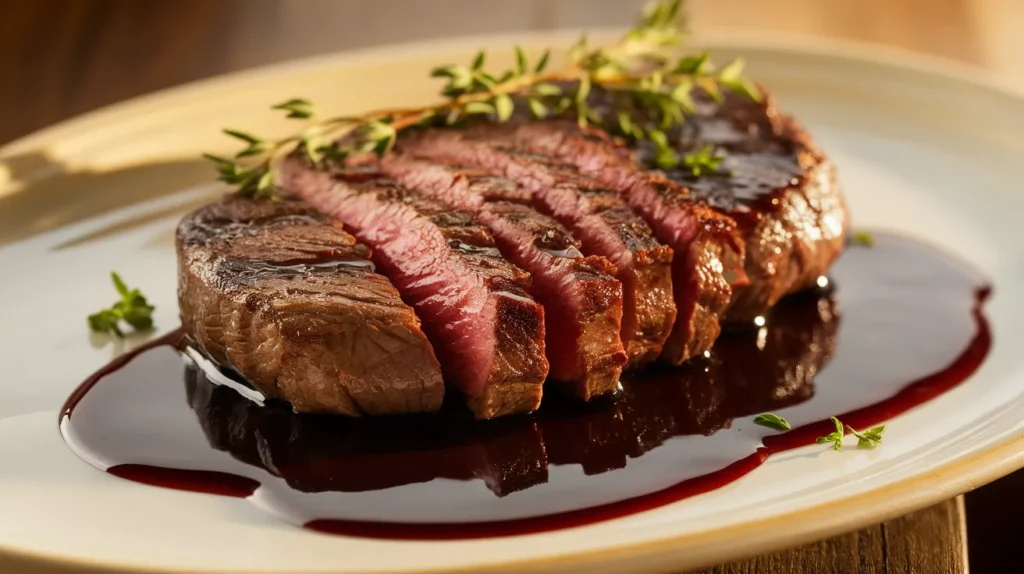
Troubleshooting Guide for Perfect Sauce
Problem: My sauce is too thin and watery Solution: Return to medium heat and simmer uncovered for 2-3 minutes to reduce further. Alternatively, whisk 1 teaspoon cornstarch with 1 tablespoon cold wine and stir into the simmering sauce until thickened.
Problem: The wine flavor is too strong or harsh Solution: Add 1-2 tablespoons additional stock and 1/2 teaspoon sugar to balance the acidity. Simmer for 1 minute to integrate flavors.
Problem: My butter separated and the sauce looks greasy Solution: Remove from heat immediately and whisk vigorously while adding 1 tablespoon cold cream. If this doesn’t work, strain the sauce and start the butter-mounting process over with the strained liquid.
Problem: The sauce tastes too salty Solution: Add 1 teaspoon heavy cream and 1/2 teaspoon sugar to counteract saltiness. You can also add a squeeze of lemon juice to brighten the flavors.
Problem: My sauce has a lumpy, grainy texture Solution: Strain through a fine-mesh sieve immediately, pressing solids gently. Whisk in 1 tablespoon warm stock to restore smoothness. This usually happens from overheating or not whisking enough during butter incorporation.
Essential Equipment for Venison Steak Sauce Success
- Medium heavy-bottomed saucepan (2-3 quart capacity prevents scorching and provides even heat distribution)
- Fine-mesh sieve (for restaurant-quality smooth texture)
- Balloon whisk (essential for proper butter emulsion)
- Wooden spoon (won’t scratch your pan and is perfect for stirring)
- Liquid measuring cups (for accurate wine and stock measurements)
- Sharp chef’s knife (for precise shallot mincing)
- Cutting board (preferably wood for knife longevity)
- Tongs or fork (for removing herb sprigs safely)
Complete Shopping List by Store Section
Produce Section
- 2 large shallots (choose firm ones without green shoots)
- Fresh thyme (1 small package or 3-4 sprigs if sold individually)
- Fresh flat-leaf parsley (1 small bunch—flat-leaf has better flavor than curly)
Wine & Spirits
- 1 bottle red wine (Cabernet Sauvignon, Merlot, or Côtes du Rhône—buy one you’d drink)
Meat & Dairy Section
- Unsalted butter (1 stick minimum—European-style butter creates richer sauce)
- Heavy cream (small 8 oz container)
Pantry & Canned Goods
- Beef stock or venison stock (32 oz container—low-sodium preferred)
- Tomato paste (small 6 oz can)
- Bay leaves (if you don’t have them)
- Fine sea salt and whole black peppercorns for grinding
Professional Success Secrets for Perfect Sauce
1. Ingredient Quality Creates Excellence: Use wine you’d happily serve with dinner—never cooking wine. Your sauce for venison steak will only be as good as the wine you choose. The same goes for stock—homemade or high-quality store-bought makes a noticeable difference.
2. Temperature Control Is Everything: Keep heat at medium or below throughout the entire process. High heat creates harsh, bitter flavors and breaks the delicate butter emulsion that makes your sauce silky and luxurious.
3. Perfect Timing Coordination: Start your sauce when your venison steaks have about 10 minutes left to rest. This ensures both components finish simultaneously, and the rested meat will slice perfectly while staying warm.
4. Straining Creates Restaurant Magic: That extra step of straining transforms good sauce into extraordinary sauce. The smooth, velvety texture impresses guests and makes your home cooking rival fine dining establishments.
5. Trust Your Palate Over Measurements: While measurements provide a framework, every bottle of wine and container of stock varies slightly. Taste frequently and adjust seasoning gradually—your palate is the best guide to perfect flavor balance.
This sophisticated sauce for venison steak transforms your wild game into an extraordinary dining experience worthy of special occasions. The rich, velvety texture and complex wine-forward flavors make it equally stunning with other proteins—it even adds elegant depth to seafood dishes like our sauce for coconut shrimp for an unexpected gourmet fusion.
Master this classic sauce technique, and you’ll have the confidence to create restaurant-quality meals that showcase venison’s unique character while impressing family and friends with your culinary expertise.
